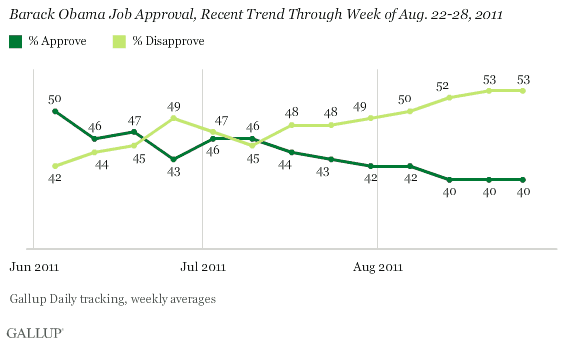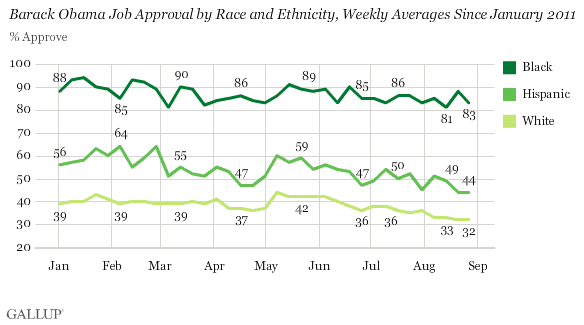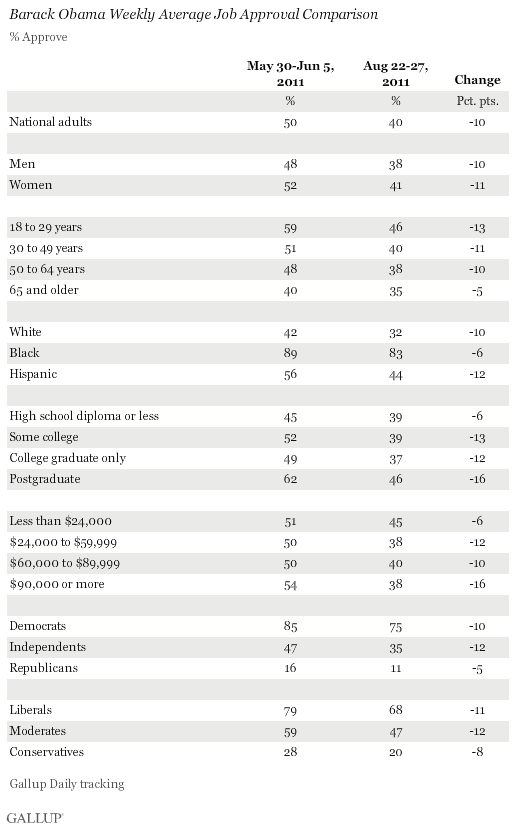PRINCETON, NJ -- President Barack Obama's job approval rating averaged 40% last week, tying his record-low 40% ratings for the two prior weeks that started on Aug. 8.

The Aug. 22-28 weekly average of Gallup Daily tracking includes Obama's worst three-day average approval rating thus far in his presidency: 38% approval and 55% disapproval from Aug. 25-27. Gallup suspended Daily tracking on Aug. 28 because of the hurricane conditions affecting much of the East Coast.
Obama continues to receive broad support from blacks (83%); however, this is the third consecutive week he has earned less than majority support from Hispanics, and the current 44% -- also registered the prior week -- is his lowest from this group. Whites' 32% average approval rating in each of the past two weeks is also a record low.

Majority Approval Isolated to Blacks, Democrats, Liberals
The last time Obama's average weekly job approval rating registered at least 50% among all Americans was May 30-June 5, 2011. Since then, his support has gradually eroded among every major demographic subgroup to the point that this is the first week that no group other than blacks, Democrats, and liberals gives him majority support.
The drop in Obama's approval rating since late May/early June has been particularly steep among postgraduates and high-income Americans. He dropped by an average amount among Democrats and liberals and by less-than-average amounts among blacks, Republicans, conservatives, and seniors, as well as among the lowest-income and lowest-education Americans.

Bottom Line
President Obama's approval rating has leveled off at the low point of his presidency, averaging 40% for the third straight week. Notably, his approval rating among several groups that previously gave him strong majority support -- postgraduates, Hispanics, 18- to 29-year-olds, and lower-income Americans -- is now below the 50% threshold.
Obama is now midway through his 11th quarter in office. While his current 40% approval could be a troubling sign for him heading into the 2012 election, previous Gallup analysis has found that incumbent presidents' ratings in their 12th and 13th quarters are much more indicative of their re-election prospects.
Explore President Obama's approval ratings in depth and compare them with those of past presidents in the Gallup Presidential Job Approval Center.
Survey Methods
Results are based on telephone interviews conducted as part of Gallup Daily tracking Aug. 22-28, 2011, with a random sample of 3,062 adults, aged 18 and older, living in all 50 U.S. states and the District of Columbia.
For results based on the total sample of national adults, one can say with 95% confidence that the maximum margin of sampling error is ±2 percentage points.
Interviews are conducted with respondents on landline telephones and cellular phones, with interviews conducted in Spanish for respondents who are primarily Spanish-speaking. Each sample includes a minimum quota of 400 cell phone respondents and 600 landline respondents per 1,000 national adults, with additional minimum quotas among landline respondents by region. Landline telephone numbers are chosen at random among listed telephone numbers. Cell phone numbers are selected using random-digit-dial methods. Landline respondents are chosen at random within each household on the basis of which member had the most recent birthday.
Samples are weighted by gender, age, race, Hispanic ethnicity, education, region, adults in the household, and phone status (cell phone only/landline only/both, cell phone mostly, and having an unlisted landline number). Demographic weighting targets are based on the March 2010 Current Population Survey figures for the aged 18 and older non-institutionalized population living in U.S. telephone households. All reported margins of sampling error include the computed design effects for weighting and sample design.
In addition to sampling error, question wording and practical difficulties in conducting surveys can introduce error or bias into the findings of public opinion polls.
For more details on Gallup's polling methodology, visit www.gallup.com.
